

Untitled. Ten Characteristics of a Modern Data Architecture. Every organization that manufactures data for decision making is rethinking its data architecture.
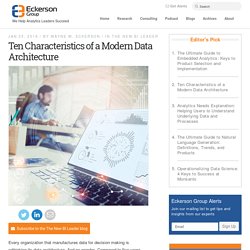
And no wonder. Compared to five years ago, there is a treasure trove of new technologies and techniques that promise to transform the way organizations compete and serve customers. Rather than react to events after the fact, modern data-driven organizations anticipate customer needs and market shifts and work proactively to optimize outcomes. Companies that don’t renovate or reinvent their data architectures will lose customers, money, and market share. There is no such thing as technical debt – Clean Code Development. Ward Cunningham coined the “technical debt” metaphor.

It sounds plausible, it might resonate with management. But it’s far from reality. Let’s think about financial debt for a moment. How do you get indebted? Agiles Datenmanagement - Datenarchitekturen. Damit beide Welten nicht nur weiter existieren, sondern voneinander profitieren können, muss die bisherige Datenmanagementinfrastruktur "agiler" werden und mehr Prozesse und Datenquellen integrieren können.
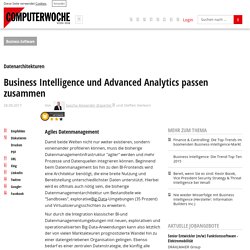
Beginnend beim Datenmanagement bis hin zu den BI-Frontends wird eine Architektur benötigt, die eine breite Nutzung und Bereitstellung unterschiedlichster Daten unterstützt. Hierbei wird es oftmals auch nötig sein, die bisherige Datenmanagementarchitektur um Bestandteile wie "Sandboxes", explorativeBig-Data-Umgebungen (35 Prozent) und Virtualisierungsschichten zu erweitern. Top Business Intelligence Tools Compared. No one knows more about how a business intelligence tool performs in the real world than the customers already using it.
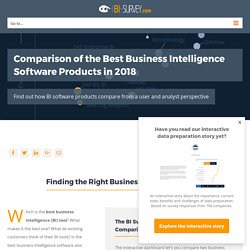
All too often, they find that products don’t live up to expectations, or that the vendor does not support its product properly. Therefore, when comparing BI software, there is almost nothing more valuable than user reviews. This is where The BI Survey comes in. Collecting feedback from business intelligence software users every year for the last 17 years, The BI Survey provides detailed analysis of which BI software products get the best user ratings. This year’s BI Survey is based on the analysis of the real-world experience of 3,066 respondents with 2,564 answering a series of detailed questions about their usage of a named business intelligence software tool.
Altogether, The BI Survey compares 42 business intelligence tools (or groups of products) in detail. Eckerson Group. Whither the Data Warehouse? Reflections From Strata NYC 2017. What’s in a name?
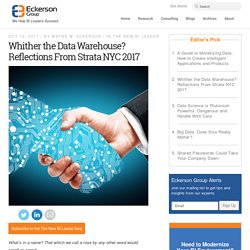
That which we call a rose by any other word would smell as sweet. From Romeo and Juliet Our industry won’t rest until it finds a suitable replacement for the venerable, if ailing, data warehouse. I attended the Strata Data Conference in New York City last month and found that the sub-text of most of my briefings was a desire to reinvent the data warehouse (DW) using new modern technology. Of course, most vendors I spoke with never said the word “data warehouse”. Truth be told, the traditional data warehouse has its problems: too slow, too costly, hard to change, and never has or will deliver a single version of truth. How to Create a Data Strategy: Part II – Ten Steps to Success. Part one of this series provided a rationale for creating a data strategy.

It stated that in the information economy, data is the lifeblood of an organization. It also described the two major components of a data strategy: a ten-step methodology to create a data strategy and a graphical framework to depict it. This article examines the first five steps in the methodology that Eckerson Group uses to help organizations create a data strategy. The next article in this series will describe the remaining five steps.
How to Create a Data Strategy - Part 1 Overview. In the information economy, data is the lifeblood of an organization.
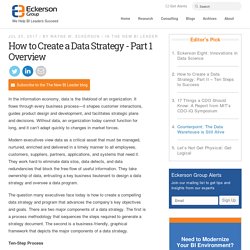
It flows through every business process—it shapes customer interactions, guides product design and development, and facilitates strategic plans and decisions. Without data, an organization today cannot function for long, and it can’t adapt quickly to changes in market forces. Modern executives view data as a critical asset that must be managed, nurtured, enriched and delivered in a timely manner to all employees, customers, suppliers, partners, applications, and systems that need it. Do You Have a BI Charter and Plan?
I’m always surprised when a new client doesn’t have a charter that describes the mission and strategy of the business intelligence (BI) and analytics program.
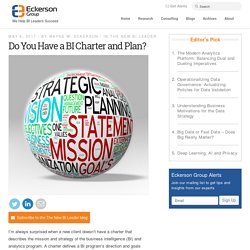
A charter defines a BI program’s direction and goals and how it plans to achieve them. It unifies team members behind a stretch vision and communicates to the outside world what the program is about. BI Tool Comparison: The Six Most Important BI Survey Findings [Infographic] The Data Doctrine - Home. How much does self-service, agile BI software cost? At 5000fish, we believe in the power of self-service, agile BI and want people to be fully educated before purchasing a solution.
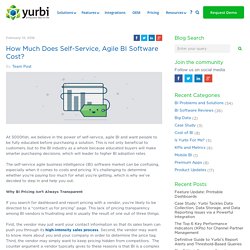
This is not only beneficial to customers, but to the BI industry as a whole because educated buyers will make smarter purchasing decisions, which will leader to higher BI adoption rates. The self-service agile business intelligence (BI) software market can be confusing, especially when it comes to costs and pricing. It’s challenging to determine whether you’re paying too much for what you’re getting, which is why we’ve decided to step in and help you out. Why BI Pricing Isn’t Always Transparent If you search for dashboard and report pricing with a vendor, you’re likely to be directed to a “contact us for pricing” page. First, the vendor may just want your contact information so that its sales team can push you through its high-intensity sales process. Why BI isn’t ready for the cloud. You’ve heard it again and again: The cloud is the new black.
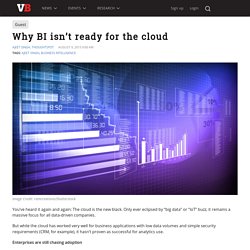
Only ever eclipsed by “big data” or “IoT” buzz, it remains a massive focus for all data-driven companies. But while the cloud has worked very well for business applications with low data volumes and simple security requirements (CRM, for example), it hasn’t proven as successful for analytics use. Enterprises are still chasing adoption Over the last two decades, companies have collectively spent billions of dollars on business intelligence tools. BusinessDictionary.com - Online Business Dictionary. BI Strategy - part 5 Conceptual Architecture an... 4.1 Business Intelligence Data Architecture 4.1.1 As-is The existing landscape uses a BW system to store data coming primarily from SAP ECC and some flat files. As a result, much information from external systems does not get integrated into the reporting environment, leading to “silos” of data for each business area.
Reporting tools are limited to BEx Analyzer (Excel based) and some web applications viewed through SAP Enterprise Portal. The end user’s ability to develop their own reports is almost non-existent. 4.1.2 To-be. Business Intelligence: BI Strategy - part 1 Tab. BI Strategy - part 2 Executive Summary. Part 2 Executive Summary. Think of this as more your elevator speech/10 minute chat on what you are doing and why. This is not what you give to your Executive Lead team.
BI Strategy - part 3 Reporting Gaps and Risks. Part 3 Reporting Gaps and Risks - yes you see these every day but you still have to document the Gaps and Risks. Not everyone lives in our world. · Standards and Processes o Do not exist or are not uniform § Design, development and management processes are informal. BI Strategy - part 4 BI Vision.